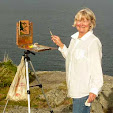Clouds Over Harbor Island
9"x12" oil on canvas panel
Windjammer Days 2017
Doing a demo is a great experience for an artist. It's a bit intimidating the first time, but once you realize that people are really interested in the process, not looking for a masterpiece, and will ask interesting questions, it's a lot of fun. I've set myself a goal of doing four demos this year, in addition to the small ones I do while teaching. Last week was my second, so things are on schedule.
Carol L. Douglas,
Ed Buonvecchio, and I were among the artists demo-ing at Boothbay Harbor's Windjammer Days last week. We were fortunate to be able to set up across the harbor from the main part of town, where we had a sensational view of not only the passing windjammers, but the moored lobster boats and Harbor Island. We were in Fisherman's Memorial Park, in front of the Our Lady Queen of Peace church, which dominates the skyline of that side of the harbor. We had lots of visitors, and lots of explaining to do. I particularly enjoyed Carol and a young man who helped her identify each of the windjammers. Not that she needs much help, she's a regular at the boatyard where several of them live. I was busy mentoring his older sister, who wants to be an artist. It is so much fun to take our work out to where people can see it happening, and help them understand the process.
American Eagle sails past a tug
Photo courtesy of Carol L. Douglas
Carol paints the island
Photo courtesy of Annette Koziel
You may ask why we didn't paint an actual windjammer. It's much easier to demo something that sticks around for a least a few minutes, which the windjammers did not. The point is to be there for the people, not to paint the technically most difficult subject you can find. But it was tempting...
I love painting in this particular spot. The island is what the word picturesque was meant to describe. I've painted it before and will likely again.
Harbor Island
5"x7" oil on gessobord
painted in 2010
And before I go, I'm excited to tell you that I'll be co-hosting the Artists Helping Artists blogtalk radio show this month with Leslie Saeta. It's such an honor to do this, and I'm thrilled. I have learned so much from this show over the years. Though the focus is on art marketing, there have been many shows interviewing artists and people who artists depend on. One of my favorites was the interview with Robert Gamblin of the Gamblin paint company. If you aren't familiar with this show, do check it out. The archives are a real treasure trove for artists.
You can listen to the show live, or to past shows which are all archived, at the link below.
http://www.blogtalkradio.com/artistshelpingartists
And you can also listen to the AHA show, as it's called, as a podcast.
This week's show is "How to Use Lists to Organize Your Art" at 11AM tomorrow.




















